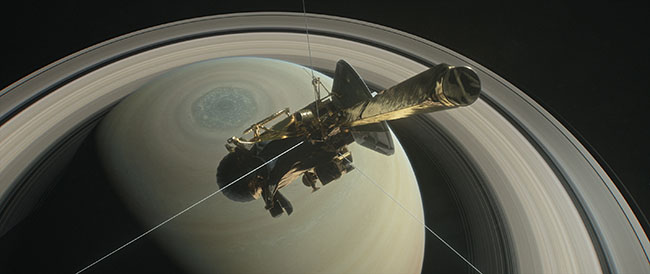After 13 years studying Saturn and its moons, the Cassini spacecraft’s mission ended on September 15, 2017. Operators at NASA intentionally directed Cassini to plunge into Saturn’s atmosphere, destroying the spacecraft before its fuel supply ran out and the ability to control the probe’s path was lost. Mission planners made this decision to protect against Cassini possibly crashing into Saturn’s moons Titan and Enceladus, which were discovered during the mission to possess environments that could potentially support alien life. See also: Planet; Saturn; Solar system; Space probe
Cassini’s fiery entry into Saturn’s clouds concluded the mission’s “Grand Finale,” as NASA called it—a series of 22 orbits that looped the spacecraft between Saturn and its famous rings. Those laps around Saturn were the last of the 294 orbits completed by Cassini since arriving in 2004, following a seven-year voyage from Earth. See also: Orbital motion

One of Cassini’s first tasks upon reaching the Saturnian system was deploying a small probe bound for Titan. Named Huygens, it parachuted through Titan’s hazy, brownish-yellow atmosphere, using a gas sensor to detect prebiotic chemicals that rain onto the ground. Huygens then landed on Titan in January 2005—the first, and so far the only, landing on a world in the outer solar system. During Cassini’s 127 total flybys of Titan, the spacecraft’s suite of instruments discerned large lakes of ethane and methane on the moon’s surface. Normally gases on Earth, these molecules liquify in Titan’s frigid, -180 degrees Celsius (-292 degrees Fahrenheit) climate. Cassini also measured the degree to which the moon’s shape changed ever so slightly under the force of gravity based on its proximity to Saturn, indicating that a liquid ocean of water likely exists in Titan's warmer interior. See also: Cassini-Huygens mission; Titan
Cassini made numerous other important discoveries at Saturn. Flybys of Enceladus revealed geysers spewing into space from cracks in its terrain, likely emanating from an underground water reservoir like Titan’s. Cassini flew right through one of the plumes and detected chemical signs of active hydrothermal vents in the moon’s interior ocean; such vents are thought to be a likely origin for life on Earth. Along with Titan, Enceladus is now considered one of the best candidate worlds for extraterrestrial life. See also: Astrobiology; Enceladus
Regarding Saturn itself, Cassini’s collected data solved longstanding mysteries about the provenance of features in its rings, and pointed to the discovery of two new, faint rings created by interactions with tiny moonlets. Cassini flew over Saturn’s poles, letting researchers on Earth see them for the first time. A surprise lay at Saturn’s north pole in the form of a giant, hexagonal-shaped cloud formation, whose six sides are each longer than Earth is wide.
Overall, the Cassini mission revolutionized our understanding of Saturn and its planetary neighborhood. Much of the previous information on Saturn had come from the short encounters by the space probes Pioneer 11, Voyager 1, and Voyager 2, which cruised past it in the 1970s and 1980s. Cassini, however, lived at Saturn for well over a decade. Fittingly enough, the ringed world is also the spacecraft’s final resting place.





